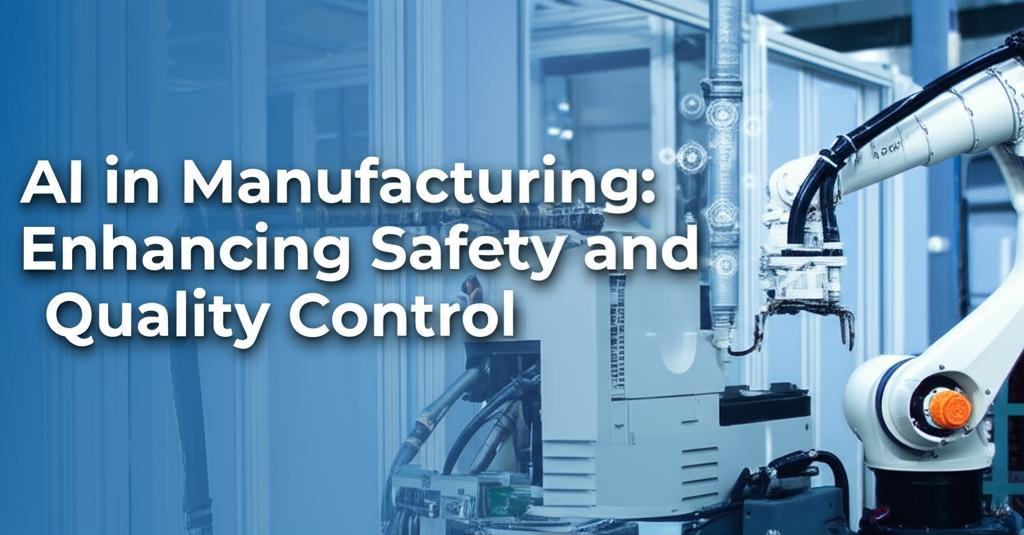The manufacturing sector is undergoing a significant transformation, with Artificial Intelligence (AI) at the forefront of enhancing both safety and quality control. AI-powered technologies are moving beyond basic automation to offer data-driven, predictive, and real-time solutions.
Enhancing Safety with AIAI is revolutionizing manufacturing safety by moving from reactive measures to proactive and predictive strategies.
- Real-Time Monitoring and Hazard Detection: AI systems, particularly those utilizing computer vision, continuously monitor factory floors. They can identify unsafe conditions, such as spills, obstacles, unauthorized personnel in restricted zones, or improper use of personal protective equipment (PPE). Real-time alerts enable immediate intervention, significantly reducing accident rates. For instance, AI can detect smoke or flames at their source, often before traditional detectors, minimizing fire damage. Similarly, AI can monitor flue spaces in warehouses to ensure they are not blocked, maintaining fire safety compliance.
- Predictive Analytics and Maintenance for Safety: AI analyzes historical and real-time data from machinery sensors to predict potential equipment failures. This predictive maintenance allows for scheduling repairs before a breakdown occurs, preventing accidents caused by malfunctioning equipment and extending the lifespan of machinery. This proactive approach also reduces unexpected downtime.
- Automated Safety Systems and Robotics: Collaborative robots (cobots) equipped with AI can handle hazardous or strenuous tasks, working alongside human workers to enhance safety. AI algorithms can trigger safety mechanisms like machine shutdowns or alarms when hazards are detected, reacting faster and more consistently than human operators in many situations. Autonomous vehicles like drones and robots can perform dangerous inspection tasks, reducing human exposure to risky environments.
- Worker Health and Fatigue Monitoring: AI-powered wearables can track workers' vital signs and detect fatigue, enabling timely interventions to prevent fatigue-related accidents. Vision AI can also identify unsafe worker behaviors, such as improper ladder use or running in work areas, allowing for immediate corrective action.
- Enhanced Training: AI-powered virtual reality (VR) simulations create realistic scenarios for employees to practice emergency responses without real-world risks, making the workforce better prepared for various hazards.
AI is also setting new standards for quality control in manufacturing, leading to higher quality products and reduced waste.
- Real-Time Defect Detection: AI-powered computer vision systems can inspect products on assembly lines with incredible speed and accuracy. These systems can identify minute defects, inconsistencies, or dimensional inaccuracies that human inspectors might miss. This leads to earlier detection of issues, reducing scrap and rework costs. Some systems achieve up to 90% accuracy in defect detection.
- Predictive Quality Analytics: By analyzing vast amounts of production data, AI can identify patterns and predict potential quality issues before they escalate. This allows manufacturers to adjust processes proactively to maintain consistent product quality.
- Process Optimization: AI algorithms analyze data from various stages of the manufacturing process to identify optimal parameters for variables like temperature, pressure, and material composition. This helps in consistently producing high-quality products and minimizing variations.
- Autonomous Quality Control: AI-driven automation allows for tasks like assembly, welding, and packaging to be performed continuously with high precision, ensuring consistent quality and increased throughput. Collaborative robots can assist human workers in quality inspection tasks.
- Streamlined Audits and Compliance: AI can streamline quality audits, helping manufacturers maintain compliance with industry standards and regulations with less manual effort.
The integration of AI in manufacturing for safety and quality control offers numerous benefits:
- Reduced Accidents and Injuries: Proactive hazard detection and automated safety responses lead to a safer working environment.
- Improved Product Quality: Higher accuracy in defect detection and process optimization result in better products and increased customer satisfaction.
- Increased Efficiency and Productivity: Automation of repetitive tasks, reduced downtime from predictive maintenance, and faster inspection processes boost overall efficiency.
- Cost Reduction: Lower accident-related costs, reduced waste and rework, optimized maintenance schedules, and decreased labor costs for manual inspections contribute to significant savings.
- Data-Driven Decision Making: AI provides real-time insights and analytics, empowering managers to make informed decisions quickly.
- Enhanced Compliance: Automated monitoring helps ensure adherence to safety and quality regulations.
The future of AI in manufacturing safety and quality control looks promising. Advancements in areas like generative AI are expected to enable even more proactive risk assessment, personalized safety recommendations, and the development of more sophisticated autonomous safety and quality systems. As AI technology continues to evolve and become more accessible, its role in creating safer, more efficient, and higher-quality manufacturing environments will only grow. Many manufacturing executives believe intelligent factory technologies, including AI, will be a key driver of competitiveness in the coming years.

